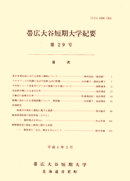Volume 29
Displaying 1-9 of 9 articles from this issue
- |<
- <
- 1
- >
- >|
-
Article type: Cover
1992Volume 29 Pages Cover2-
Published: March 25, 1992
Released on J-STAGE: June 15, 2017
Download PDF (31K) -
Article type: Article
1992Volume 29 Pages 7-10
Published: March 25, 1992
Released on J-STAGE: June 15, 2017
Download PDF (296K) -
Article type: Article
1992Volume 29 Pages 11-26
Published: March 25, 1992
Released on J-STAGE: June 15, 2017
Download PDF (962K) -
Article type: Article
1992Volume 29 Pages 27-41
Published: March 25, 1992
Released on J-STAGE: June 15, 2017
Download PDF (1074K) -
Article type: Article
1992Volume 29 Pages 43-54
Published: March 25, 1992
Released on J-STAGE: June 15, 2017
Download PDF (844K) -
Article type: Article
1992Volume 29 Pages 55-88
Published: March 25, 1992
Released on J-STAGE: June 15, 2017
Download PDF (1885K) -
Article type: Article
1992Volume 29 Pages 89-103
Published: March 25, 1992
Released on J-STAGE: June 15, 2017
Download PDF (1619K) -
Article type: Article
1992Volume 29 Pages 105-121
Published: March 25, 1992
Released on J-STAGE: June 15, 2017
Download PDF (1456K) -
Article type: Article
1992Volume 29 Pages 123-134
Published: March 25, 1992
Released on J-STAGE: June 15, 2017
Download PDF (1534K)
- |<
- <
- 1
- >
- >|
